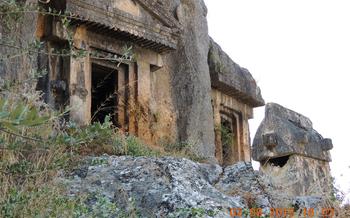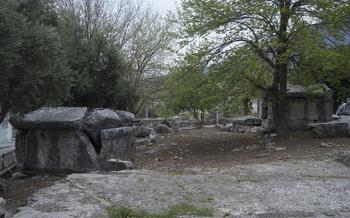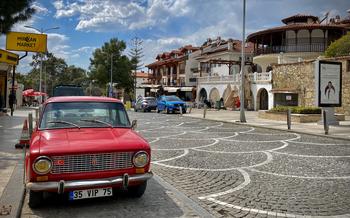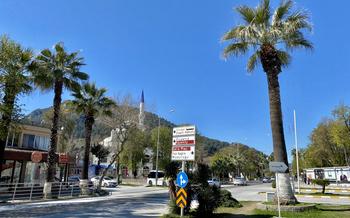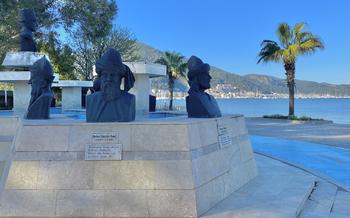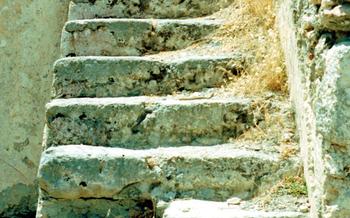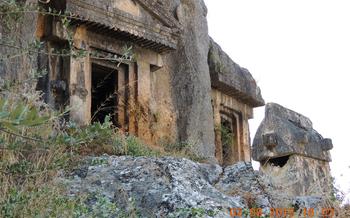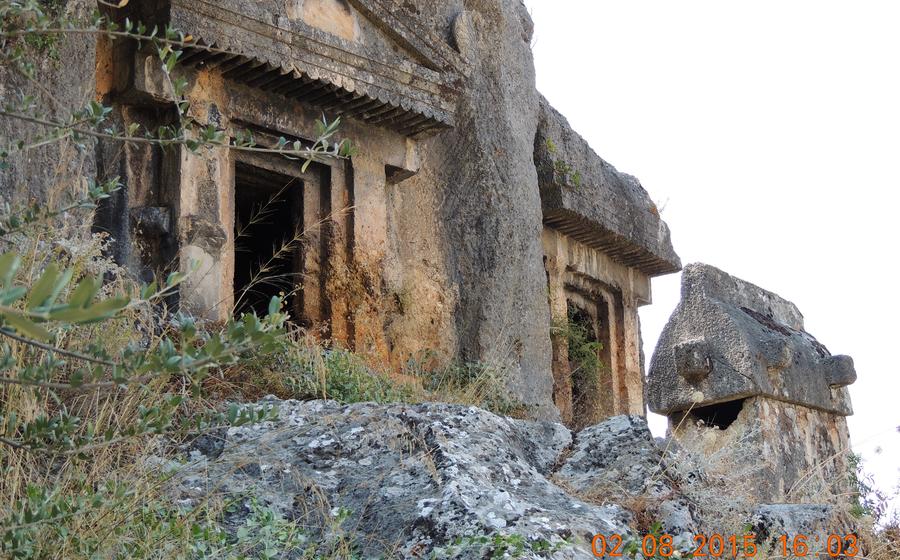
Lycian Tombs of Fethiye
- The Lycian Tombs of Fethiye: A Historical Overview
- Exploring the Different Tomb Types
- The Tomb of Amyntas: A Majestic Masterpiece
- The Tomb of the Nereids: A Work of Art
- The Harpy Tomb: A Mysterious Abode
- The Tomb of the Eagles: A Majestic Observation Point
- The Painted Tombs: A Showcase of Lycian Art
- The Tomb of Sidyma: A Hidden Gem
- The Tomb of the Satrap: A Royal Burial Chamber
- The Tomb of the Dancers: A Celebration of Life
- The Tomb of the Dolphins: A Symbol of Transformation
- The Tomb of the Columns: A Timeless Monument
- The Tomb of the Arches: A Gateway to the Beyond
- The Tomb of the Warriors: A Tribute to Valor
- Insider Tip: Plan Your Visit
The Lycian Tombs of Fethiye: A Historical Overview
The Lycian Tombs of Fethiye, carved into the rocky landscape of southwestern Turkey, stand as a testament to the rich cultural heritage of the ancient Lycian civilization. These elaborate rock-cut tombs, dating back to the 4th century BC, offer a glimpse into the Lycians' unique burial practices and their intricate artistic traditions.
The Lycians, an Anatolian people who inhabited the region during antiquity, were renowned for their seafaring skills and their sophisticated culture. Their tombs, often built on prominent hillsides or along major roads, served as a symbol of their status and power. The architectural features of these tombs vary greatly, ranging from simple chamber tombs to elaborate temple-like structures.
The influence of Hellenism, the dominant cultural force in the Mediterranean during the Hellenistic period, is evident in the Lycian tombs. Many of the tombs feature Greek architectural elements, such as columns, pediments, and friezes, alongside traditional Lycian motifs. This fusion of cultural influences resulted in a unique and visually striking style that characterizes the Lycian tombs of Fethiye.
Exploring the Different Tomb Types
The Lycian tombs of Fethiye exhibit a remarkable diversity in their structures and designs. Among the most common types are:
Rock-cut Tombs: These tombs are carved directly into the rocky cliffs and hillsides. They often feature intricate facades and decorative elements, such as columns, pilasters, and pediments. The interiors of these tombs typically consist of a main chamber and several smaller side chambers, which were used for burials and storage.
Pillar Tombs: These tombs are characterized by their tall, slender pillars that support a roof or pediment. The pillars are often decorated with carvings and inscriptions. Pillar tombs were typically built for wealthy and influential individuals, and their size and ornamentation reflected their status.
Temple Tombs: These tombs resemble small temples in their appearance. They feature a columned portico, a pediment, and a cella, or inner chamber. Temple tombs were typically built for important religious figures or members of the ruling class. They are often the most elaborate and impressive of all the Lycian tombs.
The Tomb of Amyntas: A Majestic Masterpiece
Of all the Lycian tombs in Fethiye, the Tomb of Amyntas stands out as the most impressive and well-preserved. This magnificent monument is believed to have been built in the 4th century BC for Amyntas, a wealthy and powerful Lycian ruler. Carved into a sheer rock face, the tomb's facade is adorned with intricate reliefs that depict scenes from Greek mythology, including the battle between the gods and the giants.
The tomb's most striking feature is its sheer size. Towering over the surrounding landscape, it measures an astonishing 10 meters in height and 6 meters in width. The entrance to the tomb is flanked by two massive pillars, which support a triangular pediment adorned with carvings of lions and bulls.
Inside the tomb, visitors will find a single chamber with a high vaulted ceiling. The walls are lined with benches, where mourners would have sat to pay their respects to the deceased. The tomb's most striking feature is a large sarcophagus, which is carved from a single block of marble. The sarcophagus is decorated with reliefs depicting scenes from Amyntas's life, including his battles and his hunting expeditions.
The Tomb of Amyntas is a testament to the skill and artistry of the Lycian craftsmen. It is a masterpiece of ancient architecture and a must-see for anyone visiting Fethiye.
The Tomb of the Nereids: A Work of Art
Amidst the ancient Lycian necropolis of Fethiye, the Tomb of the Nereids stands as a testament to the artistry and craftsmanship of this enigmatic civilization. This exquisitely crafted tomb, dating back to the 4th century BC, is dedicated to the Nereids, mythical sea nymphs who were daughters of the sea god Nereus.
The tomb's unique architectural style sets it apart from other Lycian tombs. Its facade is adorned with intricate reliefs depicting scenes from Greek mythology, showcasing the influence of Hellenism on Lycian culture. The most striking feature of the tomb is its iconic frieze, which features a procession of Nereids riding on sea creatures, their flowing hair and garments billowing in the wind.
The reliefs on the Tomb of the Nereids are not mere decorations; they hold deep symbolic meaning. The Nereids, often associated with fertility and the life-giving power of the sea, were believed to guide the souls of the deceased to the afterlife. The intricate carvings on the tomb thus serve as a visual representation of the Lycian belief in the journey of the soul after death.
The tomb's dedication to the Nereids also sheds light on the significance of these mythical figures in Lycian mythology. The Nereids were revered as protectors of sailors and fishermen, and their association with the sea made them important deities in a region heavily reliant on maritime trade and fishing.
The Harpy Tomb: A Mysterious Abode
Among the Lycian tombs, the Harpy Tomb stands out for its enigmatic harpy figures. These mythical creatures, often depicted as half-women, half-birds, adorn the tomb's facade, lending it an air of mystery and intrigue. Their symbolism remains a subject of debate among scholars, with various interpretations ranging from guardians of the underworld to symbols of death and transition.
One theory suggests that the harpies represent the souls of the deceased, guiding them through the journey to the afterlife. Their outstretched wings and fierce expressions may symbolize the challenges and obstacles that the soul encounters during this transition. Alternatively, some believe that the harpies represent the underworld itself, their presence serving as a warning to those who enter this realm.
Another interpretation links the harpies to the Greek myth of the Harpies, who were known for their role in punishing wrongdoers. In this context, the harpies on the tomb could represent a warning to those who would seek to disturb the peace of the deceased.
Regardless of their exact meaning, the harpies on the Harpy Tomb contribute to its unique and captivating atmosphere. They serve as a reminder of the rich mythology and symbolism that permeated Lycian culture, inviting visitors to delve deeper into the mysteries of this ancient civilization.
The Tomb of the Eagles: A Majestic Observation Point
Among the many Lycian tombs in Fethiye, the Tomb of the Eagles stands out for its unique location and striking features. Perched atop a hill overlooking the stunning turquoise waters of the Mediterranean Sea, this tomb offers breathtaking panoramic views that are sure to leave you spellbound.
The tomb's most distinctive feature is its eagle-shaped pediment, which is intricately carved with the majestic birds in flight. Eagles held a special significance in Lycian culture, symbolizing strength, courage, and the connection between the earthly and spiritual realms. The presence of these majestic creatures on the tomb suggests that the individuals buried within were highly respected and revered members of Lycian society.
In addition to its impressive pediment, the Tomb of the Eagles is also adorned with a variety of other intricate carvings and reliefs. These carvings depict scenes from mythology, daily life, and religious rituals, providing valuable insights into the beliefs and customs of the ancient Lycians. The tomb's location on a hilltop further enhances its significance, as it was believed that the closer one was to the heavens, the closer one was to the gods.
Visiting the Tomb of the Eagles is an unforgettable experience that combines history, nature, and breathtaking views. As you climb the hill towards the tomb, you'll be rewarded with stunning vistas of the surrounding landscape. Once you reach the tomb, take some time to admire the intricate carvings and soak in the serene atmosphere. The Tomb of the Eagles is a true masterpiece of ancient architecture and a must-see for anyone visiting Fethiye.
The Painted Tombs: A Showcase of Lycian Art
Among the numerous Lycian tombs in Fethiye, the Painted Tombs stand out for their vibrant frescoes and paintings. These tombs offer a unique glimpse into Lycian daily life and religious rituals. The walls are adorned with scenes of hunting, feasting, music-making, and dancing, providing insights into the customs and beliefs of this ancient civilization.
The most famous of the Painted Tombs is the Tomb of the Painted Sarcophagus, located in the Fethiye Museum. The tomb features a beautifully preserved sarcophagus with intricate paintings depicting scenes from Greek mythology, including the Trojan War and the Labors of Hercules. The vivid colors and detailed artwork make this tomb a masterpiece of Lycian art.
Other notable Painted Tombs include the Tomb of the Dancers, the Tomb of the Boats, and the Tomb of the Musicians. Each tomb offers its own unique perspective on Lycian life and culture, providing a fascinating glimpse into the past.
The Tomb of Sidyma: A Hidden Gem
Among the many Lycian tombs scattered across the region, the Tomb of Sidyma stands out as a hidden gem. Located in the ancient city of Sidyma, this tomb is remarkable for its well-preserved state and impressive architecture. While it may not be as well-known as other tombs in Fethiye, the Tomb of Sidyma offers a unique and authentic glimpse into Lycian burial practices.
The tomb is situated on a hill overlooking the ruins of Sidyma, providing visitors with breathtaking views of the surrounding landscape. Its facade is adorned with intricate carvings and reliefs, showcasing the artistic prowess of the Lycians. The interior of the tomb is equally impressive, featuring a spacious chamber with multiple niches where the deceased were laid to rest.
One of the distinguishing features of the Tomb of Sidyma is its unique architectural style. Unlike many other Lycian tombs, which are typically rock-cut or built using ashlar masonry, the Tomb of Sidyma is constructed using a combination of both techniques. This unique approach demonstrates the adaptability and ingenuity of the Lycians in their construction methods.
The Tomb of Sidyma is a testament to the rich history and cultural heritage of the Lycians. While it may not be as well-known as other tombs in the region, its significance lies in its unique architectural features and its well-preserved state. For those seeking a more off-the-beaten-path experience, the Tomb of Sidyma is a must-visit destination.
The Tomb of the Satrap: A Royal Burial Chamber
Amidst the ancient ruins of Fethiye, stands the Tomb of the Satrap, a testament to the grandeur of Lycian royalty. This imposing burial chamber is believed to have housed the remains of a powerful Lycian satrap, a governor appointed by the Persian Empire. The tomb's impressive size and elaborate ornamentation speak volumes about the satrap's status and influence.
The exterior of the tomb is adorned with intricate carvings and reliefs, showcasing scenes from Lycian mythology and daily life. The entrance, flanked by majestic columns, leads to a spacious interior chamber, where visitors can marvel at the tomb's well-preserved frescoes and paintings. These vibrant artworks depict scenes of hunting, feasting, and religious ceremonies, offering a glimpse into the life and times of the Lycian elite.
The Tomb of the Satrap is a remarkable example of Lycian funerary architecture, showcasing the skill and artistry of Lycian craftsmen. Its grand scale and opulent decorations reflect the importance of the satrap's role in Lycian society and provide valuable insights into the lives of the Lycian ruling class.
The Tomb of the Dancers: A Celebration of Life
Amidst the ancient ruins of Fethiye, the Tomb of the Dancers stands as a unique testament to the Lycian fascination with life's joyous moments. Unlike other tombs that focus on somber themes of death and the afterlife, this tomb bursts with vibrant energy, celebrating the beauty and vitality of living.
The tomb's exterior is adorned with intricate reliefs depicting lively figures engaged in various forms of dance. These graceful movements and expressive poses seem to capture the essence of joy, freedom, and celebration, inviting visitors to contemplate the importance of embracing life's pleasures.
The identities of the individuals depicted in the reliefs remain a mystery, but their lively expressions and dynamic postures suggest that they were revered members of Lycian society, perhaps renowned dancers or entertainers who left an indelible mark on their community. Their presence in this tomb serves as a reminder that even in the face of death, the memory of joy and celebration can live on.
The Tomb of the Dancers offers a refreshing perspective on Lycian culture, highlighting their appreciation for the beauty and fullness of life. It invites visitors to embrace the present moment, celebrate their passions, and find joy in the simple things, just as the ancient Lycians did.
The Tomb of the Dolphins: A Symbol of Transformation
Among the Lycian tombs, the Tomb of the Dolphins stands out with its unique and captivating reliefs depicting dolphins and other marine creatures. Dolphins, revered in Lycian mythology as symbols of transformation and rebirth, adorn the tomb's facade, inviting visitors to contemplate the journey of the soul to the afterlife. The tomb's intricate carvings showcase dolphins gracefully leaping out of the water, their bodies forming harmonious curves that evoke a sense of fluidity and movement.
The presence of dolphins on this tomb suggests that the Lycians believed in the transformative power of the sea. In their mythology, the dolphin served as a guide and protector for souls embarking on their journey to the afterlife. The dolphins' graceful movements and playful nature may have symbolized the soul's liberation from earthly constraints and its transition to a new realm of existence.
The Tomb of the Dolphins offers a glimpse into the Lycian perspective on death and the afterlife. By incorporating these marine creatures into the tomb's design, the Lycians expressed their belief in the soul's ability to transcend the physical realm and embark on a transformative journey to a new and unknown world.
The Tomb of the Columns: A Timeless Monument
Amidst the diverse collection of Lycian tombs in Fethiye, the Tomb of the Columns stands out with its simple yet elegant design. Constructed from finely cut stone blocks, this well-preserved tomb features a row of imposing columns that support a triangular pediment. The columns, with their fluted shafts and delicately carved capitals, lend a sense of grandeur to the tomb.
The Tomb of the Columns showcases the Lycians' mastery of architecture and their attention to detail. The columns are evenly spaced, creating a sense of symmetry and balance. The pediment, adorned with intricate carvings, adds a touch of ornamentation to the otherwise minimalist design. The overall effect is one of timeless elegance, reflecting the Lycians' enduring legacy.
Despite its impressive appearance, the Tomb of the Columns remains relatively unknown compared to other Lycian tombs in Fethiye. This makes it an ideal destination for those seeking a more secluded and intimate experience. Visitors can marvel at the tomb's well-preserved state and appreciate its simple yet refined beauty without the crowds.
The Tomb of the Arches: A Gateway to the Beyond
Among the Lycian tombs in Fethiye, the Tomb of the Arches stands out with its unique architectural features. Its most striking characteristic is its arched entrance, which is flanked by intricate carvings that depict mythological scenes and figures. These carvings showcase the skill and artistry of the Lycian craftsmen and provide valuable insights into their beliefs and traditions.
The arch, a symbol of transition and passage, holds great significance in Lycian culture. It represents the gateway between the realm of the living and the realm of the dead. Passing through this arch, the deceased would embark on their journey to the afterlife, where they would be reunited with their ancestors and deities.
The identity of the individuals buried within the Tomb of the Arches remains a mystery, but its elaborate design and prominent location suggest that they were likely prominent figures in Lycian society. Perhaps they were wealthy merchants, noblemen, or even members of the royal family. Their final resting place serves as a testament to their status and the importance they held in the community.
Visiting the Tomb of the Arches is a captivating experience that allows visitors to step back in time and connect with the ancient Lycian civilization. As you stand beneath its towering arch, you can almost feel the presence of those who once passed through it, embarking on their final journey to the unknown realms beyond.
The Tomb of the Warriors: A Tribute to Valor
The Tomb of the Warriors stands as a testament to the Lycian people's martial prowess and their deep reverence for their warriors. This remarkable tomb is adorned with intricate reliefs depicting scenes of fierce battles, valiant warriors engaging in combat, and triumphant victories. These carvings offer a glimpse into the Lycian culture, where warfare and military achievements were highly esteemed.
The identities of the warriors depicted in these reliefs remain shrouded in mystery, but their heroic feats are immortalized in stone. Some scholars believe that these warriors may have been prominent military leaders or soldiers who had distinguished themselves in battle, earning the honor of being laid to rest in such a prestigious tomb. Others suggest that these reliefs might represent mythical heroes or legendary warriors from Lycian folklore, whose stories of bravery and valor were passed down through generations.
Regardless of their specific identities, the warriors depicted in this tomb embody the Lycians' deep admiration for strength, courage, and the willingness to sacrifice for one's community. The Tomb of the Warriors serves as a powerful reminder of the Lycian people's martial spirit and their enduring legacy as fierce and honorable warriors.
Insider Tip: Plan Your Visit
To make the most of your visit to the Lycian Tombs of Fethiye, consider these insider tips:
Timing is Everything: The best time to visit the tombs is early in the morning or late in the afternoon to avoid the midday heat. The golden light during these hours also enhances the beauty of the tombs' intricate carvings and reliefs.
Combine and Conquer: Combine your visit to the tombs with other attractions in Fethiye. The city offers several historical and cultural sites, including the Fethiye Museum, the Old Town, and the Fethiye Castle. This will allow you to experience the rich history and diverse offerings of Fethiye.
Capture the Moment: The Lycian Tombs provide ample opportunities for stunning photography. Look for unique angles and perspectives to capture the grandeur of the tombs against the backdrop of the surrounding landscape. The play of light and shadow, especially during sunrise and sunset, can create dramatic and captivating images.
